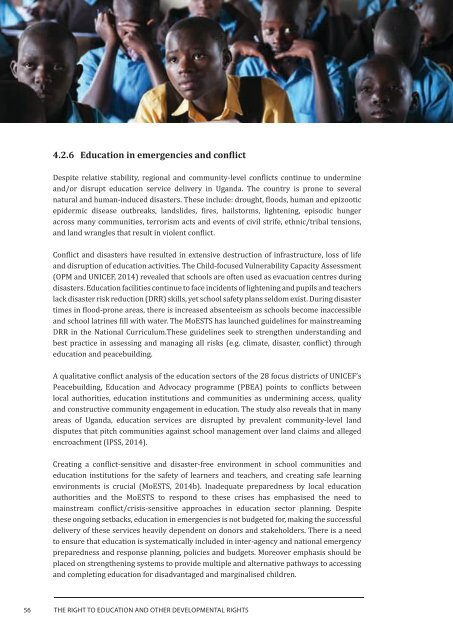Situation analySiS
1TNu802
1TNu802
You also want an ePaper? Increase the reach of your titles
YUMPU automatically turns print PDFs into web optimized ePapers that Google loves.
<strong>Situation</strong> <strong>analySiS</strong> of Children in uganda 20154.2.6 Education in emergencies and conflictDespite relative stability, regional and community-level conflicts continue to undermineand/or disrupt education service delivery in Uganda. The country is prone to severalnatural and human-induced disasters. These include: drought, floods, human and epizooticepidermic disease outbreaks, landslides, fires, hailstorms, lightening, episodic hungeracross many communities, terrorism acts and events of civil strife, ethnic/tribal tensions,and land wrangles that result in violent conflict.Conflict and disasters have resulted in extensive destruction of infrastructure, loss of lifeand disruption of education activities. The Child-focused Vulnerability Capacity Assessment(OPM and UNICEF, 2014) revealed that schools are often used as evacuation centres duringdisasters. Education facilities continue to face incidents of lightening and pupils and teacherslack disaster risk reduction (DRR) skills, yet school safety plans seldom exist. During disastertimes in flood-prone areas, there is increased absenteeism as schools become inaccessibleand school latrines fill with water. The MoESTS has launched guidelines for mainstreamingDRR in the National Curriculum.These guidelines seek to strengthen understanding andbest practice in assessing and managing all risks (e.g. climate, disaster, conflict) througheducation and peacebuilding.A qualitative conflict analysis of the education sectors of the 28 focus districts of UNICEF’sPeacebuilding, Education and Advocacy programme (PBEA) points to conflicts betweenlocal authorities, education institutions and communities as undermining access, qualityand constructive community engagement in education. The study also reveals that in manyareas of Uganda, education services are disrupted by prevalent community-level landdisputes that pitch communities against school management over land claims and allegedencroachment (IPSS, 2014).Creating a conflict-sensitive and disaster-free environment in school communities andeducation institutions for the safety of learners and teachers, and creating safe learningenvironments is crucial (MoESTS, 2014b). Inadequate preparedness by local educationauthorities and the MoESTS to respond to these crises has emphasised the need tomainstream conflict/crisis-sensitive approaches in education sector planning. Despitethese ongoing setbacks, education in emergencies is not budgeted for, making the successfuldelivery of these services heavily dependent on donors and stakeholders. There is a needto ensure that education is systematically included in inter-agency and national emergencypreparedness and response planning, policies and budgets. Moreover emphasis should beplaced on strengthening systems to provide multiple and alternative pathways to accessingand completing education for disadvantaged and marginalised children.56 thE rIGht to EDUCatIoN aND othEr DEvELoPMENtaL rIGhtS




